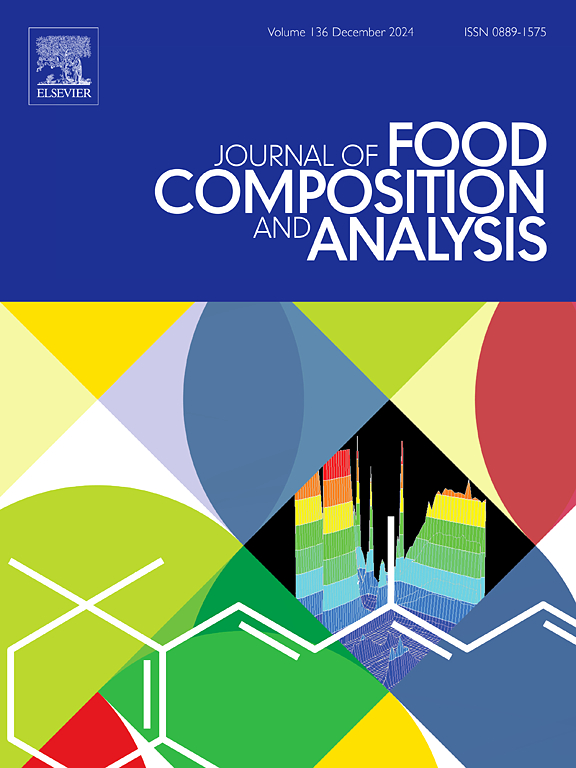一种用于氯霉素检测和潜在指纹增强的双功能荧光探针
IF 4
2区 农林科学
Q2 CHEMISTRY, APPLIED
引用次数: 0
摘要
利用绿色合成的含氮碳量子点(N-CQDs)技术,实现了食品和环境样品中氯霉素(CAP)的选择性和灵敏度检测。绿色技术采用基于绿色化学原理的微波辅助方法,通过n掺杂生产具有增强光致发光的N-CQDs。样品的结构表征证实了它们的有效含氮,球形表征(平均直径:6.49 nm)和图形结构。N-CQDs对CAP的猝灭响应强,荧光稳定性好,线性检测范围为0.5 ~ 25 μM,检出限为13.1 nM。Probe的特异性体现在它对其他抗生素的干扰具有抗性,包括四环素和阿莫西林。该工艺在实际应用中回收率为98.13 % -105.33 %,适用于牛奶、酸奶、废水和农业径流等实际基质。此外,为了进行法医调查,二氧化硅纳米复合荧光粉与N-CQDs结合。N-CQDs独特的发光特性使得潜在指纹的可视化更加详细,从而在紫外线照射下显示出明显的脊状图案。这一联合行动证明了N-CQDs在克服环境监测、法医学和食品安全方面的主要障碍方面的相关性。此外,这种方法价格合理且可扩展,这表明它具有广泛应用的潜力。本文章由计算机程序翻译,如有差异,请以英文原文为准。
Sustainable N-CQDs from Phyllanthus emblica: A dual-function fluorescent probe for chloramphenicol detection and latent fingerprint enhancement
Selective and sensitive detection of chloramphenicol (CAP) in food and environmental samples was achieved through green-synthesis of nitrogen-doped carbon-quantum-dots (N-CQDs) from Phyllanthus emblica. Green-technique employs a microwave-assisted-approach that is founded on green chemistry principles to produce N-CQDs with enhanced photoluminescence through N-doping. Structural characterization of samples confirmed their effective nitrogen incorporation, spherical-characterization (average-diameter: 6.49 nm), and graphitic-structure. N-CQDs exhibit robust quenching response to CAP and remarkable fluorescence-stability, with a linear-detection-range of 0.5–25 μM and detection limit of 13.1 nM. Probe's specificity is demonstrated by its resistance to interference from other antibiotics, including tetracycline and amoxicillin. Process demonstrated practical utility by achieving recovery rates of 98.13 %–105.33 % in real-world matrices such as milk, yogurt, effluent, and agricultural runoff on application. Additionally, silica nanocomposite phosphors were combined with N-CQDs for the purpose of conducting a forensic investigation. Unique luminous qualities of N-CQDs enabled the visualization of latent fingerprints in a more detailed manner, which in turn revealed distinct ridge patterns under UV illumination. This combined action demonstrates the relevance of N-CQDs in overcoming the primary obstacles in environmental monitoring, forensic science, and food safety. Additionally, this approach is reasonably priced and scalable, which suggests that it has potential for widespread application.
求助全文
通过发布文献求助,成功后即可免费获取论文全文。
去求助
来源期刊

Journal of Food Composition and Analysis
工程技术-食品科技
CiteScore
6.20
自引率
11.60%
发文量
601
审稿时长
53 days
期刊介绍:
The Journal of Food Composition and Analysis publishes manuscripts on scientific aspects of data on the chemical composition of human foods, with particular emphasis on actual data on composition of foods; analytical methods; studies on the manipulation, storage, distribution and use of food composition data; and studies on the statistics, use and distribution of such data and data systems. The Journal''s basis is nutrient composition, with increasing emphasis on bioactive non-nutrient and anti-nutrient components. Papers must provide sufficient description of the food samples, analytical methods, quality control procedures and statistical treatments of the data to permit the end users of the food composition data to evaluate the appropriateness of such data in their projects.
The Journal does not publish papers on: microbiological compounds; sensory quality; aromatics/volatiles in food and wine; essential oils; organoleptic characteristics of food; physical properties; or clinical papers and pharmacology-related papers.
 求助内容:
求助内容: 应助结果提醒方式:
应助结果提醒方式:


